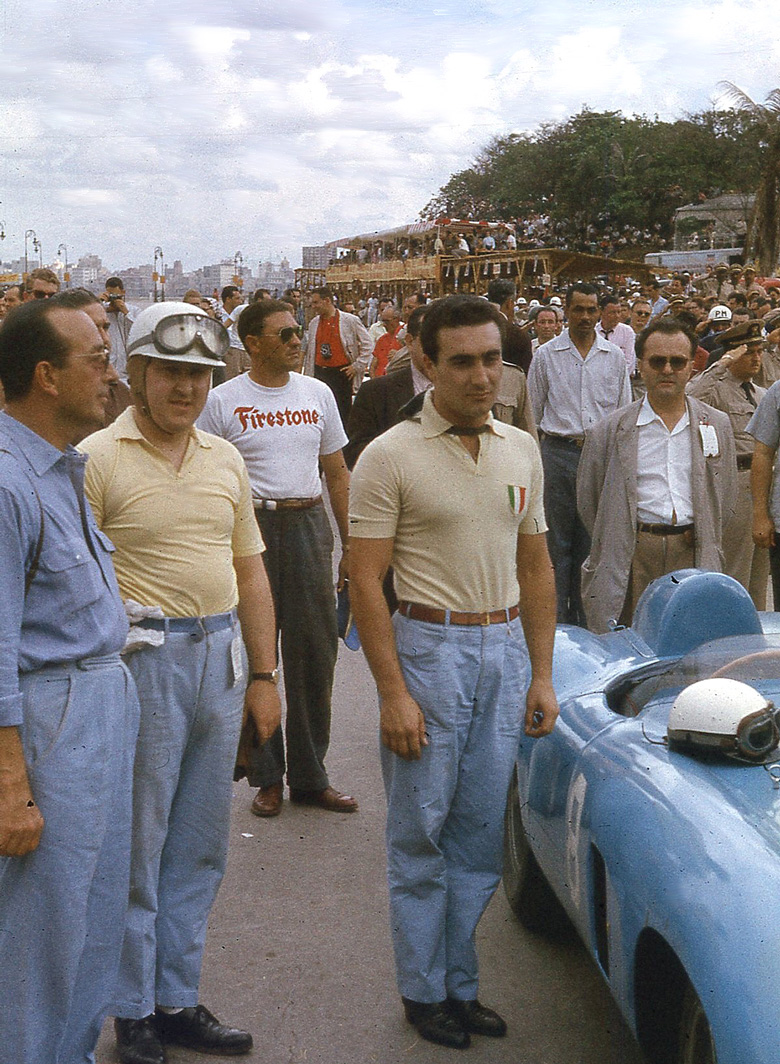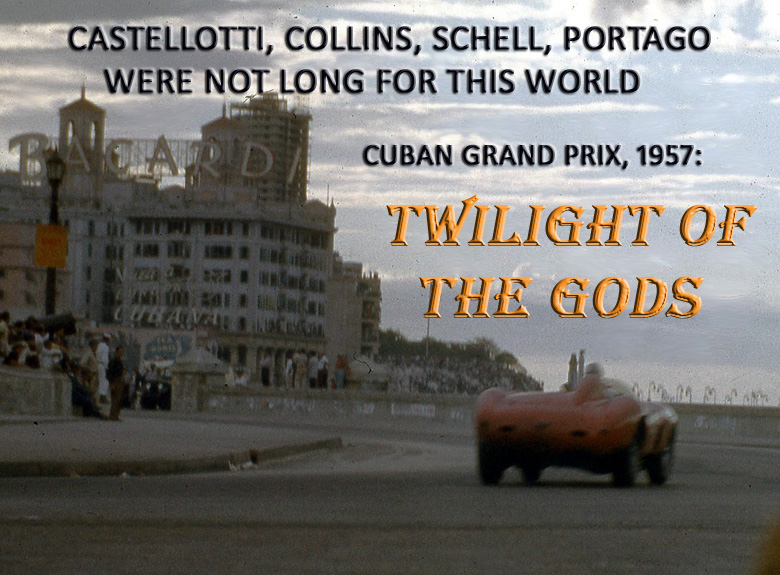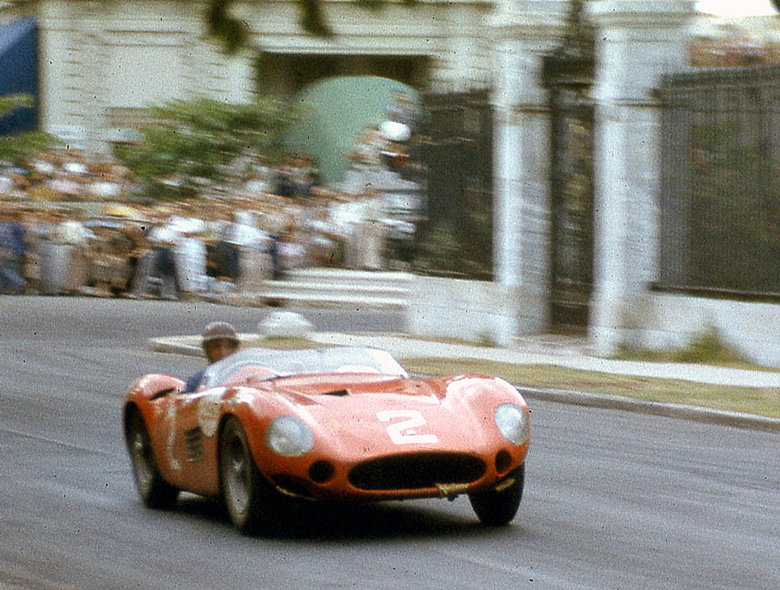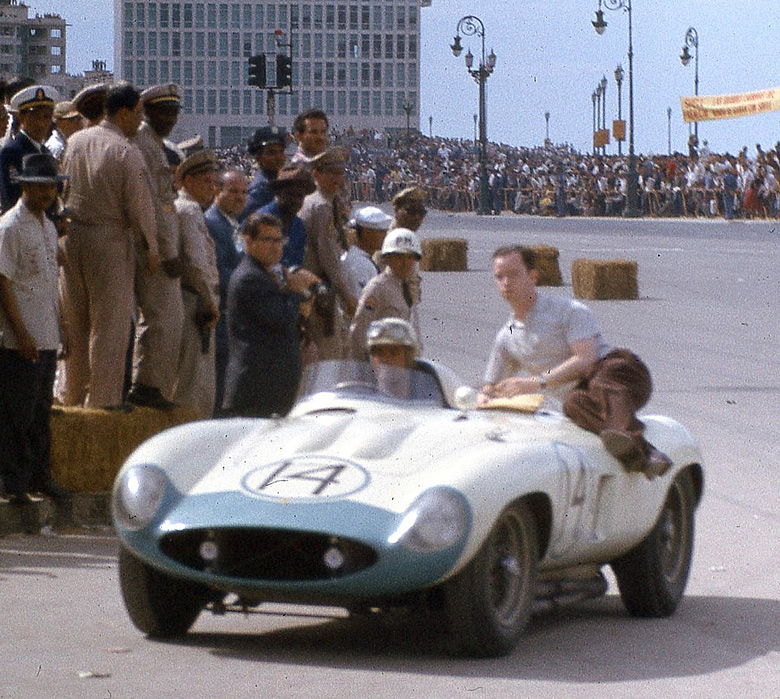By Pete Vack
Photos by Robert Pauley
A brief excerpt from “Cuban Grand Prix 1957”
When, in 1957, Robert Pauley wanted to go to Cuba “…to get a chance to see his heroes”, he may well have added “before it was too late,” for he would bear witness to the end of a very great era of motor racing.
It was not the end, not yet. But the Cuban Grand Prix held at the dawn of 1957, was the beginning of the end of an era. Just ahead would be four significant occurrences: the rear-engine revolution, the end of the Ferrari-Maserati wars, the retirement of Juan Manuel Fangio, and the tragic deaths of a high number of first class drivers born between 1926 and 1932. Not only would we lose the hero drivers, but the classic front engine race car, the constant danger, the sportsmanship, and the romance. We need not apologize for borrowing the dramatic title from Wagner…read on and you’ll realize that this was heavy stuff indeed.
The most tragic aspect of the Twilight of the Gods was the demise of so many talented drivers in the course of a few years’ time. Fangio retired after the French Grand Prix in 1958 after finishing fourth. No one would ever be able to see the great man drive in anger again. A new generation of tigers were snapping at the heels of Fangio. They were heroes or believed themselves to be heroes; all were born within a few years of each other and most would die within a few years of each other in the same tragic manner. Below, we highlight only a few of the greats that raced at Cuba.
Juan Manuel Fangio
Although Michael Schumacher won the title seven times to Fangio’s five, the two simply can’t be compared on an equal basis; to do so would be unfair to both. Almost as soon as Fangio, already old at 35, arrived in Europe after WWII, it was obvious that the man possessed unsurpassed talent. In Cuba, now age 46, he drove with the stealth of a master, who allowed for the passions of Portago and wisely waited until the Ferraris had fuel problems, then went on to win, all while giving Portago his due. Fangio could afford it. Fangio passed away at the age of 84 on July 17, 1995.
Peter Collins
Peter Collins, born in 1931, was remembered as a superb driver, ladies’ man and a great sportsman who gave his Ferrari – and the championship – to Fangio in 1956. Collins realized perhaps too late that there was more to life than racing. Three years younger than his “Mon Ami Mate” Mike Hawthorn, Collins would die at the Nurburgring on August 3rd, 1958.
Alfonso de Portago
Cuba would be Portago’s next to last race. After competing at Sebring in March, he prepared for the 1957 Mille Miglia. Born in 1928, Portago was perhaps the most legendary of all the young lions who should have dueled for the throne vacated by Fangio. Ironically, Cuba was Portago’s finest hour; after the race Fangio admitted that Portago was the true victor. His life was lived to the fullest, but ended on May 12, 1957 on the Mille Miglia near Guidizzolo.
Phil Hill
Phil Hill (b. 1927) was of the same generation as Portago (b. 1928), Collins (b. 1931), Hawthorn (b. 1929) and Castellotti (b. 1930) and von Trips (b. 1928). He had bad luck in Cuba, but it was still the beginning of a long and successful career. America’s first World Champion was also one of motor racing’s best ambassadors, passing away in 2008.
Oliver Gendebien
Oliver Gendebien, (b.1924) drove a good race at Cuba, not letting the big cars break Bill Helburn’s two liter Ferrari. Gendebien always drove smart and was a four time Le Mans winner. His F1 career was less than stellar but foreshortened. Under pressure from his wife, he retired in 1962 and lived to tell his story. He died in October of 1998.
Eugenio Castellotti

A somber Castellotti just before the race started. Cuba 1957 would be his last race. Can you identify the others in this photo?
Eugenio Castellotti (b.1930) raced for seven years, from 1951 to March 14, 1957. The Cuban Grand Prix would be his last race. Still a hero in his hometown of Lodi, Castellotti is perhaps one of the forgotten idols of the fifties. Yet he was arguablyone of the very best, and proved it time and time again when Castellotti Ferrari was the only real competition for the might of the Mercedes team in 1955. But despite winning the Mille Miglia in 1956 in the pouring rain (at an average speed of 85.40 mph) and winning at Sebring with Fangio, on the Grand Prix Ferrari team he was overshadowed by Peter Collins and Fangio. But his future was secure; no one had any doubt that Castellotti had the potential to be a World Champion. He died testing an 801 Ferrari at Modena.
Harry Schell
Schell, a bit older than his rivals (b. 1921) exemplified the carefree, amateur driver who was far too good to be called an amateur. But bear in mind that few drivers of that era were full-time professional race drivers. Always the practical joker, Schell enraged Tony Brooks (who, like Moss, drove for a living) by cutting across the infield at the U.S. GP at Sebring in 1959, thus taking the pole. Harry was killed in May of 1960 practicing at Silverstone.
Wolfgang von Trips, Masten Gregory, Stirling Moss, Carroll Shelby
Along with Masten Gregory, Wolfgang von Trips (b. 1928) finished 8th at Cuba in 1957. In opposition to the career of Gendebien, Trips really came into his own behind the wheel of the Ferrari 156 Sharknose in 1961. Fighting for the World Championship with his teammate Phil Hill, he met his fate at Monza on September 10th, 1961.
Of all the drivers, the most voted not to survive was Masten Gregory (b. 1932), who sustained a number of serious crashes during his career. He is best remembered for winning the 1965 Le Mans 24 hour. Despite the many accidents, Gregory died in his sleep of a heart attack in November of 1985.
Stirling Moss (b. 1929) had a career-ending accident in early 1962 that prevented him from obtaining a World Driver’s Championship. Generally reckoned to be Fangio’s equal in sports cars, he knew the chance to win the World Championship title would come in 1958 after Fangio’s retirement. He lost by only one point to Mike Hawthorn, who had won only one Grand Prix but built up a series of good finishes. Hawthorn (b. 1929) would die at the end of 1958 in a road car accident.
Carroll Shelby’s (b. 1923) exploits are well known, but his racing days are all too often eclipsed by his days as a manufacturer. This is sad, as Shelby was a better race driver than businessman. In Cuba he took the big Edgar 410 Ferrari to second place, no doubt earning some much needed dollars. He had a remarkable career and went on to win at Le Mans in 1959 with the Aston Martin. Shelby died in May of 2012.
SUBSCRIBE AND GET THE FULL STORY, FREE




Mimmo Dei of Centro-Sud on the left in the photo with Castellotti.
Based on a photo in Joel Finn’s Cuba book, the driver with the pudgy face between Dei and Castellotti must be Piero Carini. He raced a Ferrari 375 Plus rather slowly before retiring. The photo shows the same face and same helmet.
Luigi Chinetti is the man wearing the sunglasses behind the headrest of the blue Monza 860 of Castellotti. Luigi Chinetti managed to get most of the Ferrari that made it to the race by calling all his customers. The Europian cars were never unloaded in New York due to a longshoremen’s strike.(something that happened a lot in NY during the 50’s)
This photo seems to have been taken during the playing of the Cuban National Anthem. Note the Cuban Military on the right presenting arms, and everyone standing at attention. In those far off days, respect was shown.
Carini the driver mentioned by friend Willem
was the fearsome 4.9 Ferrari owned b y John Edgar
of Hollywood
Edgar certainly had many top drivers of the era
including Phil Hill, Richie Ginther, Dan Gurney
Masten Gregory, Jo Bonnier
and of course Carroll Shelby and Jack Mc Afee.
Jim sitz
Interesting that Carini was also killed in 1957….